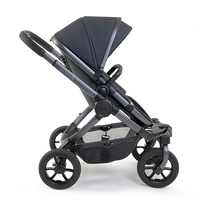

Combination Feeding
National Breastfeeding Week is the perfect time to celebrate and support the diverse ways parents choose to nourish their babies. While breastfeeding and formula feeding are often seen as mutually exclusive options, there's a flexible middle ground known as combination feeding. This approach blends the benefits of both breastfeeding and bottle feeding, accommodating the varied needs and lifestyles of modern families.
When it comes to feeding your baby often breast milk or formula milk spring to mind, but infant feeding doesn’t have to be all or nothing and knowing about the option of combination feeding is important too. Many new parents wonder if they can combine breastfeeding and bottle feeding so it is reassuring to know that you can.
What is Combination Feeding?
Put simply combination feeding is the combination of feeding via a breast and via a bottle and that bottle may contain expressed breastmilk or formula milk.
Combination feeding can be a great option for parents who want to share the responsibility of feeding, have other commitments that make exclusive breastfeeding difficult such as work or other children or when there are difficulties with breastfeeding.
How to Combination Feed?
If you plan to combination feed then it is best to establish breastfeeding first and then introduce a bottle this time frame will vary between each of us but usually takes around 4-6 weeks.
The key consideration when introducing a bottle is to be gradual, this benefits both your body by protecting your milk supply without causing engorgement complications but also your baby as feeding from a bottle is a new skill for them too. Babies who are used to breastfeeding will need to suck a little differently to drink milk from a bottle and so this may take some time to adapt to. Every baby is an individual and so they may take to combination feeding differently and at different speeds.
If combination feeding with formula milk then it is important to know that because your breasts will notice a reduction in breastmilk demand your supply will reduce over time.
Your milk supply is very easily influenced in the earliest weeks and so starting with 1 bottle a day allows you both to adapt slowly for a smoother transition to combination feeding.
How to introduce a bottle…
Because it is different for your baby to feed from a bottle than a breast it is best to use a slow flow teat which helps mitigate nipple confusion and mirror the way breastmilk flows naturally to help your baby to adapt.
Choose a time when baby is happy, content and not too hungry to feed from the bottle and if they aren’t readily accepting it you may wish to ask someone else to feed so they don’t smell your breastmilk. Holding baby in a different position for the bottle to how you hold when breastfeeding can also help.
When feeding your baby with a bottle it is recommended to practice responsive bottle feeding, but simply this means trying to respond quickly to your baby’s needs, not being distracted during feeding time and not encouraging your baby to overeat or finish bottles once they are full. This involves looking out for feeding cues and initiating a feed before they become too agitated, holding baby close in a semi-upright position during feeding with lots of eye contact and talking or singing to them. Start by inviting baby to open their mouth by just gently rubbing the teat against their top lip and once they have accepted the teat keep the bottle just slightly tipped in a horizontal position to prevent the milk flowing out too fast.
Watch and look for your baby’s signs they need a break from the bottle and respond to this. Once baby has had enough milk and no longer accepts the bottle avoid trying to get them to finish it as this can be uncomfortable for them and lead them to being overfed.
Remember that however you choose to feed your baby the main thing is that you feed with love.
Written by Midwife Pip
Pip is an experienced practicing NHS Midwifery Sister, MSc, author of Midwife Pip’s Guide to a Positive Birth, KGH hypnobirthing diploma, founder of the Midwife Pip Podcast, pelvic health specialist, pre and postnatal trainer and, importantly, a mum. Pip is an enthusiast of all things women’s health and wellness. Having worked with many families, for many years Pip sees every day the void in high quality information available. Pip is on a mission to change this and to make sure that all women can access the information they deserve and need to be empowered and supported through their pregnancy, birth and postpartum journeys.


















